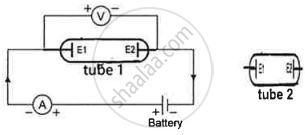Advertisements
Advertisements
प्रश्न
The circuit depicted in the figure is employed for studying Ohm's Law. Instead of using a standard resistor, a student opts for a glass tube filled with mercury (tube 1), connected to the circuit through two electrodes E1 & E2. He records the readings of the ammeter and voltmeter, thereby calculating the resistance. The student repeats the experiment by substituting tube 1 with tube 2, where the same amount of mercury fills the tube 2.

Neglecting internal resistance of the cell use (> or < or =) to compare
- the resistance in both the cases.
- the voltmeter readings in both the cases.
- the specific resistance in both the cases.
उत्तर
- Resistance of the tube 2 < Resistance of the tube 1.
- The voltmeter reading for tube 1 is the same as for tube 2.
- The specific resistance in both cases is the same.
APPEARS IN
संबंधित प्रश्न
Will current flow more easily through a thick wire or a thin wire of the same material, when connected to the same source? Why?
Name the law which is illustrated by the above V−I graph.
The graph between V and I for a conductor is a straight line passing through the origin.
Which law is illustrated by such a graph?
How should the two resistances of 2 ohms each be connected so as to produce an equivalent resistance of 1 ohm?
Calculate the current flowing through a wire of resistance 5 Ω connected to a battery of potential difference 3 V.
A wire has a length of 2.0 m and a resistance of 5.0 Ω. Find the electric field existing inside the wire if it carries a current of 10 A.
State and define Ohm’s law.
Two cells each of 5V are connected in series across an 8Ω resistor and three parallel resistors of 4Ω, 6Ω, and 12Ω. Draw a circuit diagram for the above arrangement. Calculate
- the current drawn from the cell
- current through each resistor
A current of 0.8 A flows in a conductor of 40 Ω for 1 minute. The heat produced in the conductor will be ______.
